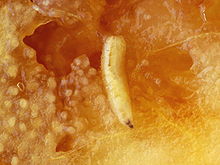- Ceratitis capitata
-
Ceratitis capitata 
Scientific classification Kingdom: Animalia Phylum: Arthropoda Class: Insecta Order: Diptera Family: Tephritidae Genus: Ceratitis Species: C. capitata Binomial name Ceratitis capitata
(Wiedemann, 1824)Synonyms Ceratitis capitata, the Mediterranean fruit fly, or medfly for short, is a species of fruit fly capable of causing extensive damage to a wide range of fruit crops. It is native to the Mediterranean area, but has spread invasively to many parts of the world, including Australasia and North and South America.
Contents
Life cycle
Adult medflies lay their eggs under the skins of fruit, particularly where the skin is already broken. The eggs hatch within three days, and the larvae develop inside the fruit. The adults have a limited ability to disperse, but the global fruit trade can transport infected fruit over thousands of miles.
Invasions
In the United States, C. capitata has invaded four states (Hawaii, California, Texas and Florida), but has been eradicated from all but Hawaii. The medfly has been spotted in California as recently as mid September of 2009.[1] It has also been eradicated from New Zealand and Chile.
California medfly crisis
Much research has been dedicated to means of controlling the medfly. In particular, use of the sterile insect technique has allowed the species to be eradicated from several areas.
In 1981, California Governor Jerry Brown, who had established a reputation as a strong environmentalist, was confronted with a serious medfly infestation in the San Francisco Bay Area. He was advised by the state's agricultural industry, and the US Department of Agriculture's Animal and Plant Health Inspection service (APHIS), to authorize airborne spraying of the region. Initially, in accordance with his environmental protection stance, he chose to authorize ground-level spraying only. Unfortunately, the infestation spread as the medfly reproductive cycle out-paced the spraying. After more than a month, millions of dollars of crops had been destroyed and billions of dollars more were threatened. Governor Brown then authorized a massive response to the infestation. Fleets of helicopters sprayed malathion at night, and the California National Guard set up highway checkpoints and collected many tons of local fruit; in the final stage of the campaign, entomologists released millions of sterile male medflies in an attempt to disrupt the insects' reproductive cycle.
Ultimately the infestation was eradicated, but both the Governor's delay and the scale of the action has remained controversial ever since. Some people claimed that malathion was toxic to humans, as well as insects. In response to such concerns, Brown's chief of staff, B. T. Collins, staged a news conference during which he publicly drank a small glass of malathion. Many people complained that, while the malathion may not have been very toxic to humans, the aerosol spray containing it was corrosive to car paint.
During the week of September 9, 2007, adult flies and their larvae were found in Dixon, California. The California Department of Food and Agriculture (CDFA) and cooperating county and federal agricultural officials started eradication and quarantine efforts in the area. Eradication was declared on August 8, 2008, when no "wild" (i.e. non-sterile) medflies were detected for three generations.
On November 14, 2008, four adult flies were found in El Cajon, California. The San Diego County Agricultural Commission implemented a treatment plan, including distributing millions of sterile male flies, local produce quarantines, and ground spraying with organic pesticides.[2]
Australia
In 2011, Japan banned imports of blueberries from Australia, because of "concerns they might be contaminated with Mediterranean fruit fly".[3]
External links
External identifiers for Ceratitis capitata EOL 723951 ITIS 143196 NCBI 7213 Also found in: Wikispecies - The 1981 California Medfly Panic
- CISR Summary on Mediterranean Fruit Fly
- Species Profile - Mediterranean Fruit Fly (Ceratitis capitata), National Invasive Species Information Center, United States National Agricultural Library. Lists general information and resources for Mediterranean fruit fly.
References
- ^ "County planning quarantine after Medfly discovery in Escondido". September 16, 2009. http://www.cbs8.com/Global/story.asp?S=11145854.
- ^ Susan Shroder (November 14, 2008). "Medfly treatment begins In El Cajon". San Diego Union-Tribune. http://www.signonsandiego.com/news/metro/20081114-1708-bn14medfly.html.
- ^ "Japan import ban threatens Australian blueberry farmers". September 28, 2011. http://www.radioaustralia.net.au/connectasia/stories/201109/s3328960.htm. Retrieved October 30, 2011.
- University of Hawaii. "Crop Knowledge Master". http://www.extento.hawaii.edu/kbase/crop/Type/ceratiti.htm.
- "Global Invasive Species Database". http://www.issg.org/database/species/ecology.asp?si=521&fr=1.
- L. E. Carroll, I. M. White, A. Freidberg, A. L. Norrbom, M. J. Dallwitz & F. C. Thompson (July 15, 2005). "Pest Fruit Flies of the World". http://delta-intkey.com/ffa/www/cer_capi.htm.
- M. C. Thomas, J. B. Heppner, R. E. Woodruff, H. V. Weems, G. J. Steck and T. R. Fasulo. "Mediterranean fruit fly, Ceratitis capitata (Wiedemann) (Insecta: Diptera: Tephritidae)". http://entomology.ifas.ufl.edu/creatures/fruit/mediterranean_fruit_fly.htm.
Categories:- Dacinae
- Agricultural pest insects
- Invasive animal species
- Animals described in 1824
Wikimedia Foundation. 2010.

